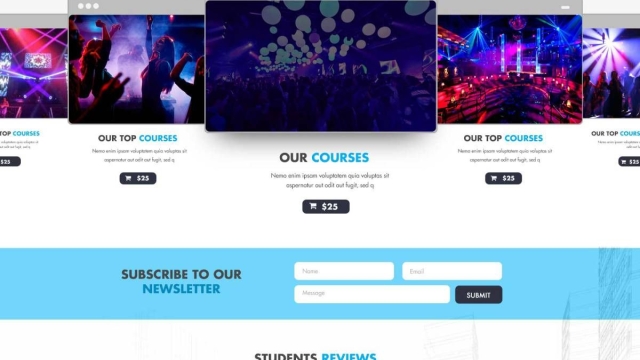
Unleashing Creative Web Designs: A Feast for the Eyes
In the vast expanse of the digital universe, websites have become the virtual storefronts of modern businesses. It is the design of these online platforms that acts as the captivating gateway, alluring visitors with its visual prowess and creative flair. With each click, users expect to be greeted by a feast for the eyes, an immersive experience that not only communicates the brand’s essence but also leaves a lasting impression. This is where the art of website design comes into play, as designers strive to unleash their creative prowess and craft captivating online experiences that engage and inspire. Whether it’s the use of vibrant colors, innovative layouts, or seamless animations, the world of web design offers limitless possibilities to create digital masterpieces that transcend traditional boundaries and spark curiosity in the hearts of users. So, let’s dive into the realm of website design and explore how these digital canvases can transform mere web pages into stunning works of art.
The Art of Visual Hierarchy
Great website design is all about creating a visual experience that captivates and engages users. One of the key elements that plays a crucial role in this process is the art of visual hierarchy.
Visual hierarchy is the arrangement and organization of design elements in a way that guides the viewer’s attention. It helps users navigate through a website effortlessly, directing their focus to the most important information first.
In website design, visual hierarchy can be achieved using various techniques such as size, color, contrast, and placement. By strategically utilizing these elements, designers can create a hierarchy of importance, allowing users to quickly and intuitively understand the content and the intended message of a website.
In a well-designed website, important information such as headlines, call-to-action buttons, and key messages are given prominence through larger font sizes, bold colors, and strategic placement. This draws the eye and communicates the priority of these elements, ensuring that users can easily find and engage with the most critical aspects of the site.
By mastering the art of visual hierarchy, designers can unleash the creative potential of web design, creating visually stunning and effective websites that provide a seamless user experience.
Striking Balance between Functionality and Aesthetics
When it comes to website design, finding the perfect balance between functionality and aesthetics is crucial. A website needs to not only look visually appealing but also provide a seamless user experience. Here, we explore the importance of striking this balance.
One of the key aspects of a successful website design is ensuring that it is user-friendly and easy to navigate. It should be intuitive for visitors to find what they are looking for and to perform any desired actions. A cluttered or confusing layout can deter users and lead to high bounce rates. Therefore, it is vital to prioritize functionality and usability to enhance the overall user experience.
At the same time, aesthetics play a significant role in captivating visitors’ attention and conveying the brand’s identity and message effectively. Visual elements, such as color schemes, typography, and images, contribute to the overall look and feel of a website. A visually appealing design can create a positive first impression and make the website memorable. By incorporating visually pleasing elements, designers can engage users and leave a lasting impact.
However, it is important to remember that aesthetics should never compromise functionality. While a beautifully designed website may initially attract users, if it lacks usability or fails to fulfill its purpose, visitors will quickly lose interest. Therefore, achieving a balance between functionality and aesthetics is essential to create an engaging and effective web design.
By prioritizing both functionality and aesthetics, website designers can ensure that their creations provide an enjoyable user experience while effectively communicating the brand’s message. Striking the right balance between these two elements will result in a visually appealing, user-friendly website that captivates visitors and entices them to explore further.
Creating Unique User Experiences
Today, website design plays a crucial role in captivating audiences and retaining their interest. By focusing on creating unique user experiences, designers have the power to leave a lasting impression on visitors. With endless possibilities and the advancements in technology, designing a visually stunning website has become an art form in itself.
One of the key aspects in creating unique user experiences is through the use of interactive elements. By incorporating interactive features into a website, designers can engage visitors and make them active participants in the browsing process. Whether it’s through interactive menus, scroll-based animations, or draggable elements, these interactive features breathe life into a static webpage.
Another way to create a distinctive user experience is by utilizing bold and striking visuals. A visually appealing website captures attention and leaves a lasting impact. Designers can experiment with vibrant colors, playful illustrations, and eye-catching imagery to create a memorable visual experience for visitors. When combined with thoughtful typography choices and creative layouts, these visuals can elevate a website design to new heights.
Furthermore, personalization is a powerful tool in creating unique user experiences. By tailoring content and design elements to individual users, websites can create a more personalized and engaging experience. This may include recommending relevant products, customizing the interface based on user preferences, or even integrating social media feeds to showcase personalized content. The ability to adapt and cater to individual needs enhances the user experience by making it more relevant and meaningful.

In conclusion, creating unique user experiences in website design is crucial in today’s digitally-driven world. By implementing interactive elements, utilizing striking visuals, and embracing personalization, designers can captivate audiences and leave a lasting impression. As technology continues to evolve, the possibilities for creating visually stunning and immersive web designs are endless. So, let’s unleash our creativity and create web designs that are true feasts for the eyes!



